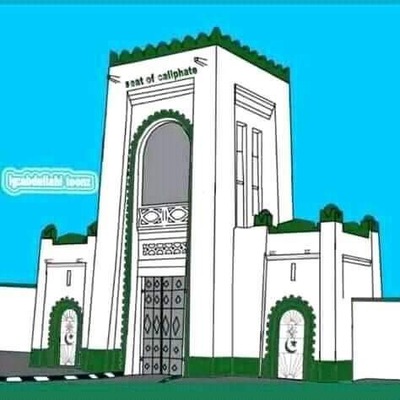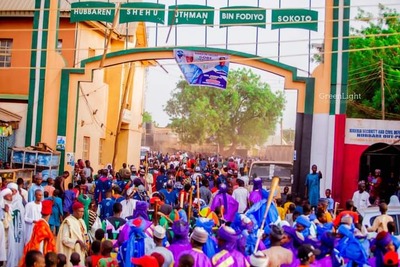
Usman Dan Fodio formed the Sokoto Caliphate in 1809 during the Fulani War. The governmental rule of the Caliph was abolished, and the region came under the control of the Northern Nigeria Protectorate in 1903, but the title of Sultan was kept. Muslims in the area still regard it as a crucial religious stance.
In the 1800s, one of the most important empires in Africa was the independent Sokoto Caliphate, which had been established independently since 1804. They grew mid numerous, autonomous Hausa kingdoms, uniting over 30 different emirates and over 10 million people to become an empire.
By the late eighteenth century, many Muslim academics and educators had grown tired of the instability that pervaded the Hausa republics and Borno. Some clerics (mallams) remained in residence at the courts of the Hausa states and Borno, but others, who joined the Qadiriyah brotherhood, started to consider a revolution that would topple the current government. Fodio, who, along with his brother and son, developed a following among the clerical class, was one of these extreme mallams who stood out.
ALSO READ
Because of his (Fodio) ethnicity, he was able to appeal to all Fulani, especially the wealthy cattle owners and clan leaders whose clients and dependents constituted the majority of the troops in the jihad that started in Gobir in 1804. Although, not all Mallams were Fulani.
Jibril, one of Fodio’s professors and the first cleric to issue a call for jihad two decades earlier was Tuareg. Abd as-Salam, the priest whose deeds truly initiated the jihad, was Hausa. However, the key leaders at the time the Hausa were overthrown in 1808 were all Fulani.
Concurrent uprisings confirmed the existence of a broad underground of Muslim revolutionaries across the Hausa states. The Hausa nations had been conquered by 1808, but the ruling families retreated to the borders and established walled cities that remained independent. The most notable of these autonomous cities were Abuja, where the deposed Zaria Dynasty fled; Argungu in the north, which became the new capital of the Kebbi monarchs; and Maradi in present-day Niger, which served as the retreat of the Katsina Dynasty.
Borno did not fall, despite the destruction of Birni Gazargamu and the toppling of the Borno Mai. Al Kanemi, another priest, organized a fierce resistance that eventually pushed the Fulani in Borno to go west and south, which was the main factor in this development. Al Kanemi eventually destroyed Borno’s centuries-old Sayfawa Dynasty and installed his own family as the new reigning house.

The Sokoto Caliphate was the name given to the new state that emerged during Usman Dan Fodio’s war and was named after his capital city of Sokoto, which was established in 1809. A loose alliance of emirates known as the caliphate acknowledged the sultan as the supreme leader of the faithful.
Usman Dan Fodio’s son, Muhammad Bello, replaced him after he died in 1817. The caliphate was nominally divided into eastern and western sections as a result of a disagreement between Bello and his uncle, Abdullahi, although Bello’s supreme authority as caliph was upheld.
The establishment of a twin capital at Gwandu, which was in charge of the western emirates as far as Sing in contemporary Mali and initially as far west as Upper Volta in present-day Burkina Faso, institutionalized the division. As it turned out, the eastern emirates were larger and more populous than the western ones, which reaffirmed the caliph’s supremacy in Sokoto.
There were thirty emirates and the capital district of Sokoto by the middle of the nineteenth century, while Sokoto itself was a sizable and populated territory even if it was not an official emirate. All of the significant Hausa emirates fell directly under Sokoto, including Kano, which was the richest and most populous.
Geographically, Adamawa, which was founded by Fulani who was forced to flee Borno, was the largest, extending into present-day Cameroon far to the south and east of its capital city of Yola. The Oyo cavalry, the backbone of the king’s power, had its first headquarters in Ilorin, which later joined the caliphate in the 1830s.
In 1817, the cavalry general attempted a coup d’état, but it failed when the cavalry rose and swore allegiance to the Sokoto Caliphate. The majority of the cavalry was made up of Muslim slaves from further north who considered the jihad a reason for insurrection. After Oyo was ripped apart in the 1820s, the vanquished king and the warlords of the Oyo Mesi fled south and established new cities, including Ibadan, where they continued their resistance to the caliphate and engaged in intra-group warfare.
After Songhai fell in 1591, Usman Dan Fodio’s jihad established the biggest empire in Africa. The Sokoto Caliphate covered a large portion of the Benue River valley, the Nupe regions, Ilorin in northern Yorubaland, and a 1,500-kilometer stretch from Dori in contemporary Burkina Faso to southern Adamawa in Cameroon by the middle of the nineteenth century, when it was at its largest. Beyond Nigeria’s borders, Usman dan Fodio’s jihad served as the model for several analogous holy wars that resulted in the establishment of Islamic governments in Senegal, Mali, the Ivory Coast, Chad, the Central African Republic, Chad, and Sudan.
Regarding its wide-ranging effects, comparisons have been made between Usman Dan Fodio’s jihad and the French Revolution. Similar to how the French Revolution impacted nineteenth-century European history, the Sokoto jihad had an impact on events from Senegal to the Red Sea on the savanna.
